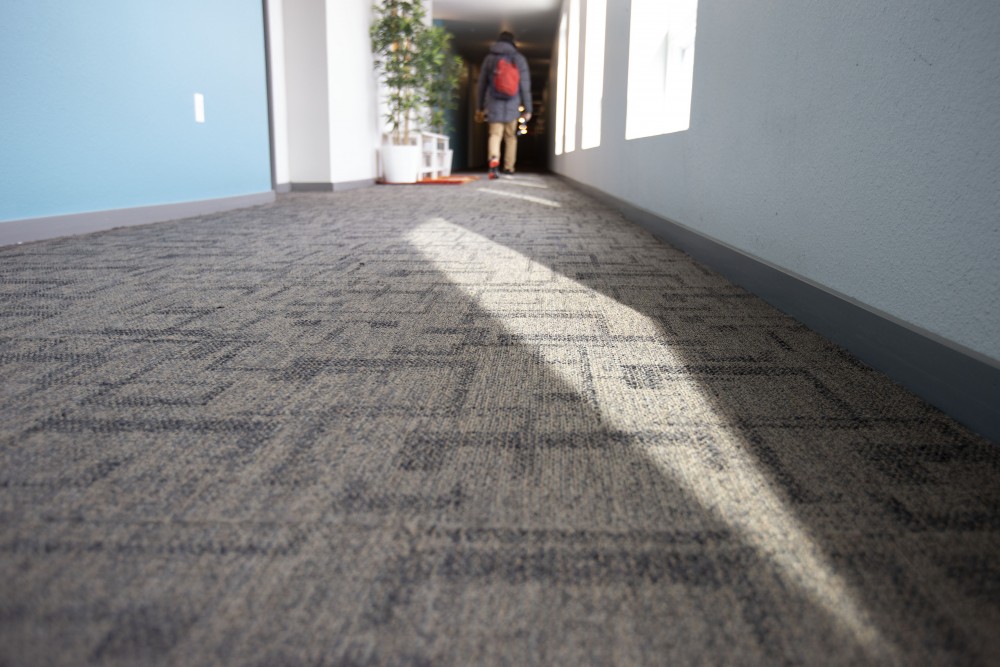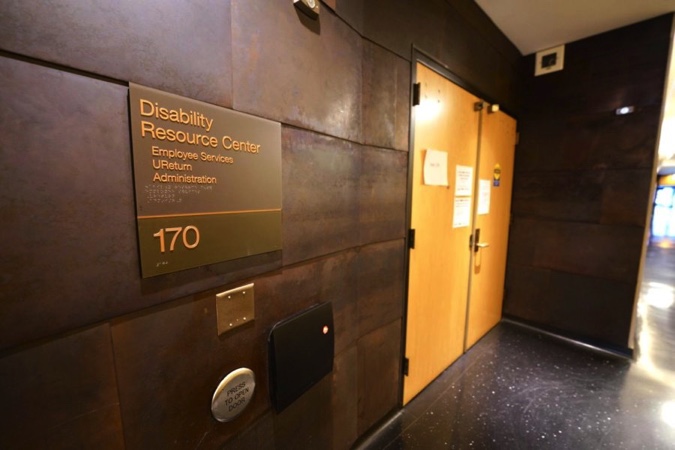Ulysses Eldridge gagged from gasoline fumes when he was filling up his car last fall.
A few weeks before, he and two other workers went to the emergency room feeling sick after installing carpeting at the student apartments formerly known as Prime Place.
Chemicals on the carpeting installed in September present potential hazards to workers’ health, according to a recently completed lab analysis initiated by the Minneapolis Building and Construction Trades Council. The recent report resulted from workers’ concerns about the carpet’s effect on their health at the building now known as The Arrow Apartments.
Following the incident in September, the City of Minneapolis Health Department also tested air quality at the apartment building. City tests showed elevated levels of the same types of potentially hazardous chemicals as the recent third-party report did, but the chemical readings dropped significantly after the City instructed they ventilate the building.
Both the Occupational Safety and Health Administration, which also filed an inspection report on the incident in the fall, and the City closed their cases after concluding there were no immediate safety concerns with the project. The City plans to send an inspector in to test air quality in the building, according to Patrick Hanlon, director of environmental programs at the City of Minneapolis Health Department.
It’s been about six months since Eldridge went to the hospital, and he said he’s still experiencing symptoms like impaired memory function, ringing in his ears and fatigue. He said he’s extra-sensitive to harsh odors like paint and gasoline fumes, which are common to encounter in his profession installing carpets.
The Arrow, which is located at 117 27th Ave. SE., is marketed to University of Minnesota students. Initial delays in construction forced residents who had already signed leases to look for temporary housing while the building was finished. Inspections in November 2017 identified serious building code violations and safety fire safety concerns associated with the ongoing construction project. Two months later, the apartments rebranded to The Arrow.
“It’s the tail end of a nightmare for this whole construction project,” said Ward 2 City Council member Cam Gordon, who has voiced concern over issues with the building’s construction since the Kansas-based developer called Elsey Partners proposed the project in 2015.
A general manager with The Arrow Apartments said he received the report, but had no comment about the incident. The Minnesota Daily reached out to the company’s management multiple times for comment.
Workers’ alarm leads to inspections
Eldridge has been laying carpet for nearly 30 years. When he started noticing abnormal symptoms during the installation in early September, he ordered an air quality testing device on Amazon. Its readings jumped to red when it measured the carpet, he said.
The third-party lab’s recent analysis found a mixture of chemicals including ethyl hexanol and multicomponent solvents similar to naphtha, Stoddard solvent or petroleum distillate, seeped from the carpet tiles. Together, the mixture of chemicals shows readings that “significantly exceed” criteria for typical levels in the air, according to the Ecology Center report.
“We identified that this product is contributing to an air quality hazard to workers,” said Jeff Gearhart, an environmental health researcher at the Ecology Center.
Those risks can include irritation of the eyes, nose and throat, nausea, fatigue, loss of coordination, dizziness and damage to the liver, kidneys and central nervous system, Gearhart said over email. Symptoms depend on the severity of the exposure.
Despite the initial high readings of the toxic organic volatile compounds, or TVOCs, the release rate of chemicals from the carpeting slows down over time, Gearhart said.
Initial symptoms are waning, Eldridge said. But now he’s worried about the potential for long-term effects.
“This is a lesson that’s going to stick,” Eldridge said. “I’m not going to let it happen again.”
City inspections find initially high levels of chemicals, but safe levels today
City inspections tell the same story as the lab analysis: they initially found high chemical readings, which dropped after ventilating the building.
The City of Minneapolis Health Department responded to the case in September after learning of workers’ health concerns, Hanlon said.
“We had an immediate … concern to make sure that it wasn’t an immediate risk to health and safety,” Hanlon said.
Gearhart said the City’s test results from September are consistent with the recent findings that the carpet tiles could pose a significant hazard to workers handling the material.
Using the City’s laboratory work, OSHA also conducted an inspection of “alleged safety or health hazards” resulting from workers’ concerns with the project. As with the City, the incident resulted in a closed inspection.
The City has been in contact with the property owners and managers, Minnesota Department of Health and other experts following the release of the third-party report, looking to identify how to handle these situations moving forward, Hanlon said.
“I would love to know where we can start to go, and when I say we, I mean the building industry and everyone … so we’re not reacting to cases like this,” he said.
Experience leads to further questions
“Nobody ever told me this when I was growing up, about laying carpet, but carpet is dangerous anyway, even if it’s not like this,” said Eldridge, who got his first job laying carpet when he was 14. “I guess you can get sick anyway. But you shouldn’t get sick in [a few] days.”
As an independent contractor, he’s ineligible for workers’ compensation. When he asked if the company would pay his medical bills in November, one of the owners replied with one word: “no.” Eldridge says he hasn’t worked for them since.
Safe exposure levels to TVOCs, which are found in materials like glues, adhesives and permanent markers, are poorly regulated, according to the Ecology Center report. Experts contacted for this article say a lack of regulation poses greater potential safety risks for workers.
Mixed and unknown chemicals are associated with both known and unknown health impacts, due to the uncertainty of the exact chemical composition, said Gearhart, who analyzed the carpet tiles.
As a chemical safety trainer, Gearhart said manufacturers and builders bear some responsibility for ensuring the materials they use are safe.
Council member Gordon, who represents the Prospect Park neighborhood where The Arrow is located, said it’s not always clear how to redress damage done by exposure to these chemicals.
“It’s hard to figure out who has jurisdiction to do what, when can we intervene and what authority we have,” Gordon said. “That’s why the ball kind of gets tossed around.”
The carpet tiles used at The Arrow were made in China. Most industry workers undergo training with carpets produced in Georgia, not carpeting made outside of the U.S., said Burt Johnson, an attorney for the North Central States Regional Council of Carpenters.
“We’re disturbed by what was reported in this case from workers,” Johnson said. “Every construction worker should be able to go home safe at night.”
He said he’s never seen a case like this.
“When you rent an apartment or you buy home or you work in an office building, you take for granted that the people who installed the materials were professionals. … And you take for granted that those materials couldn’t possibly cause [the workers] harm,” Johnson said. “This case asks the question, ‘can we take that for granted anymore?’”




























